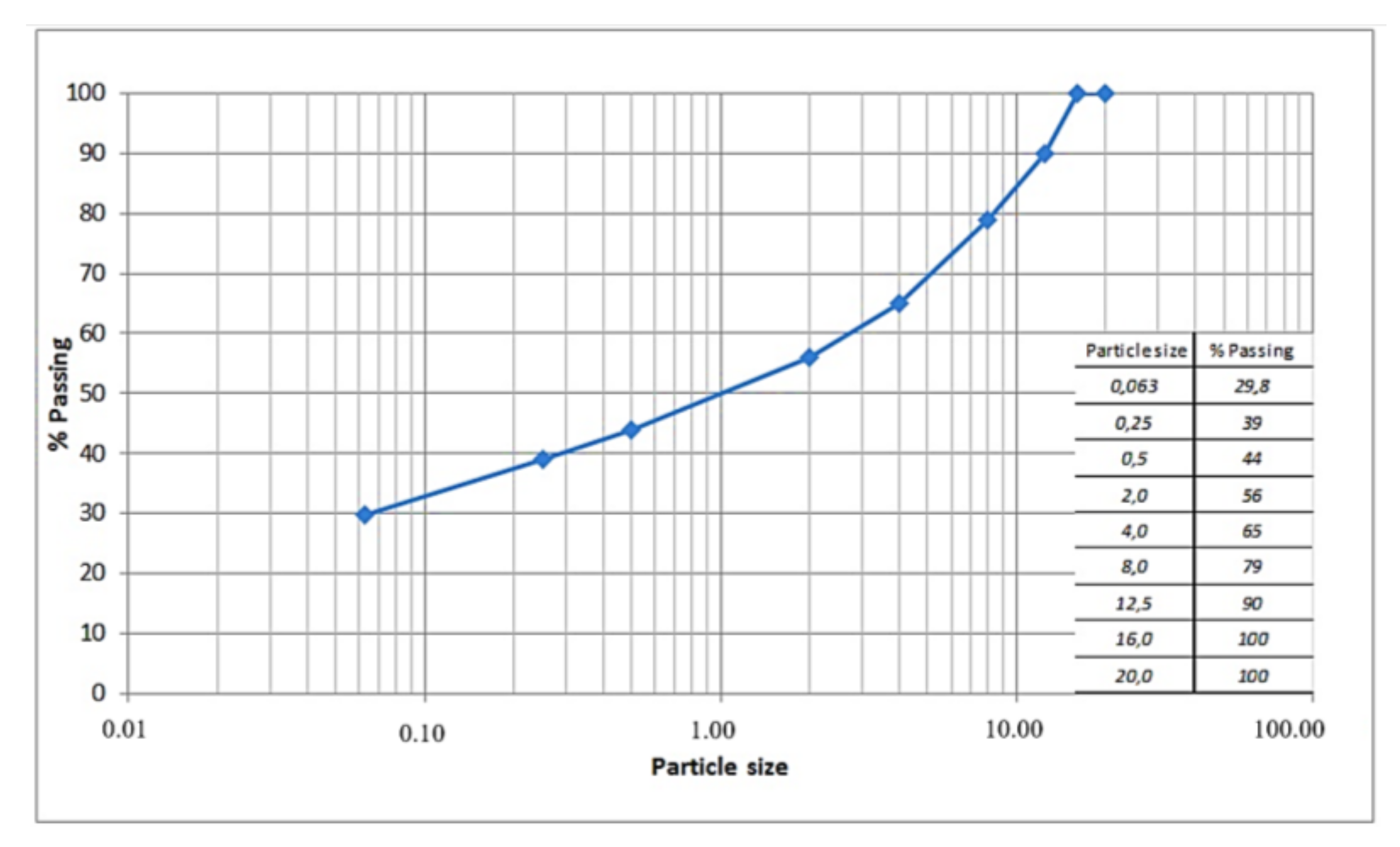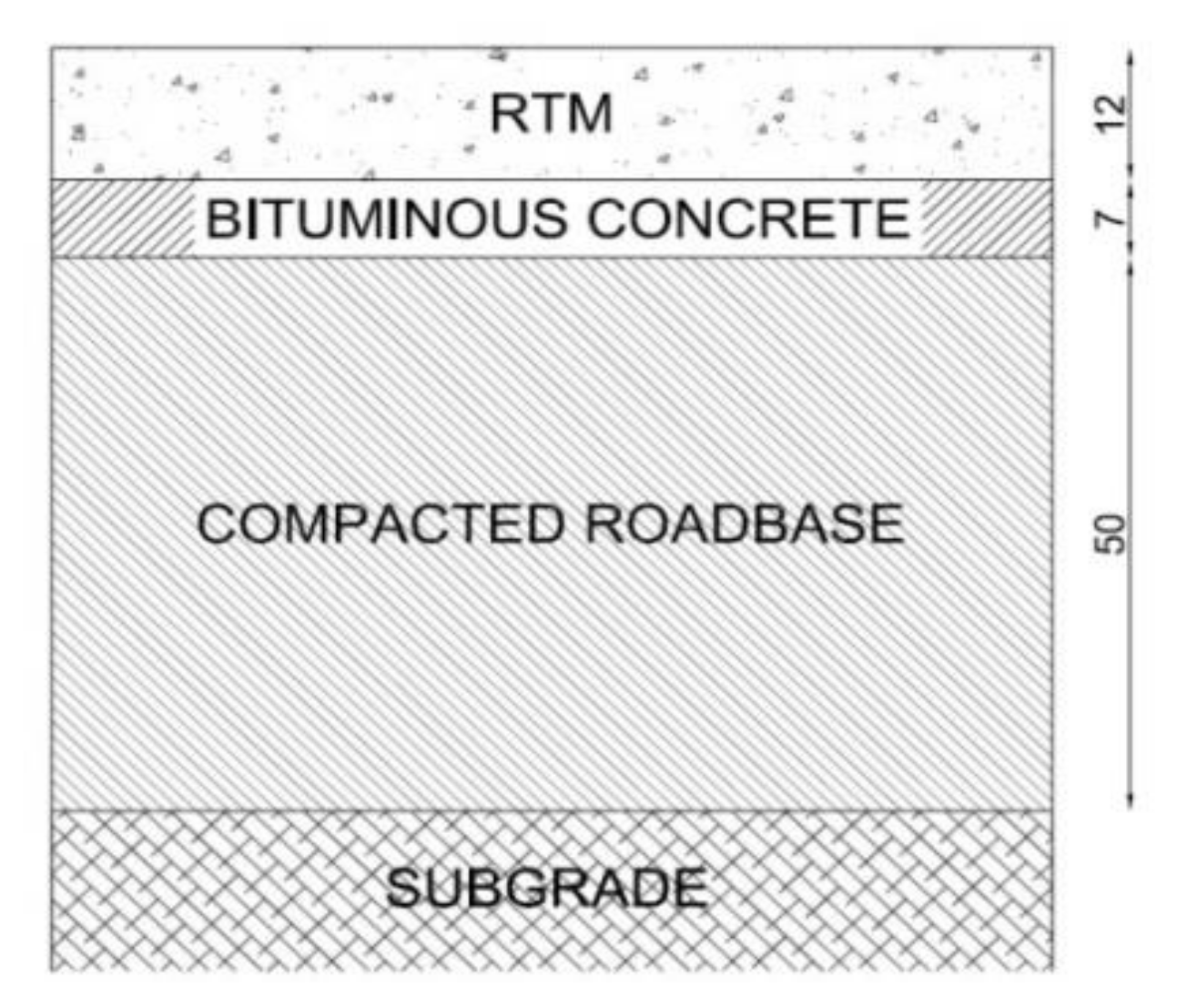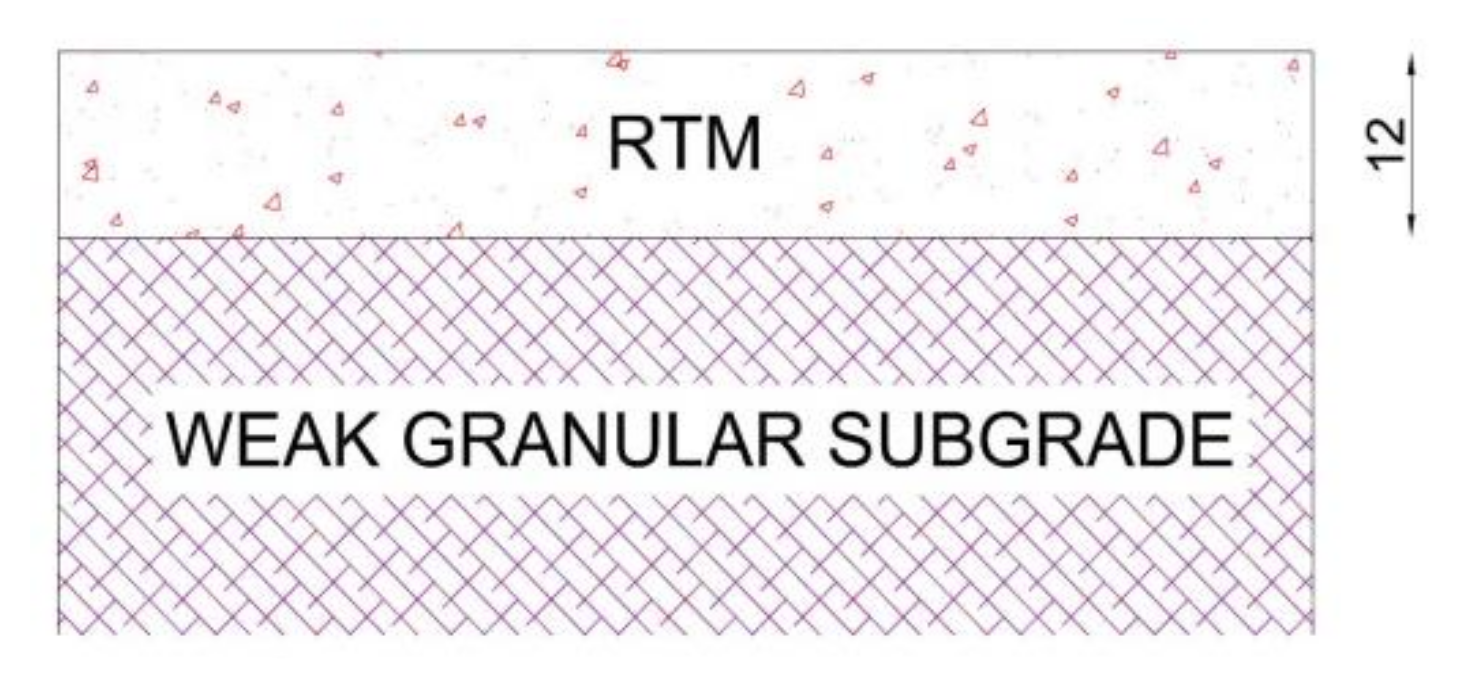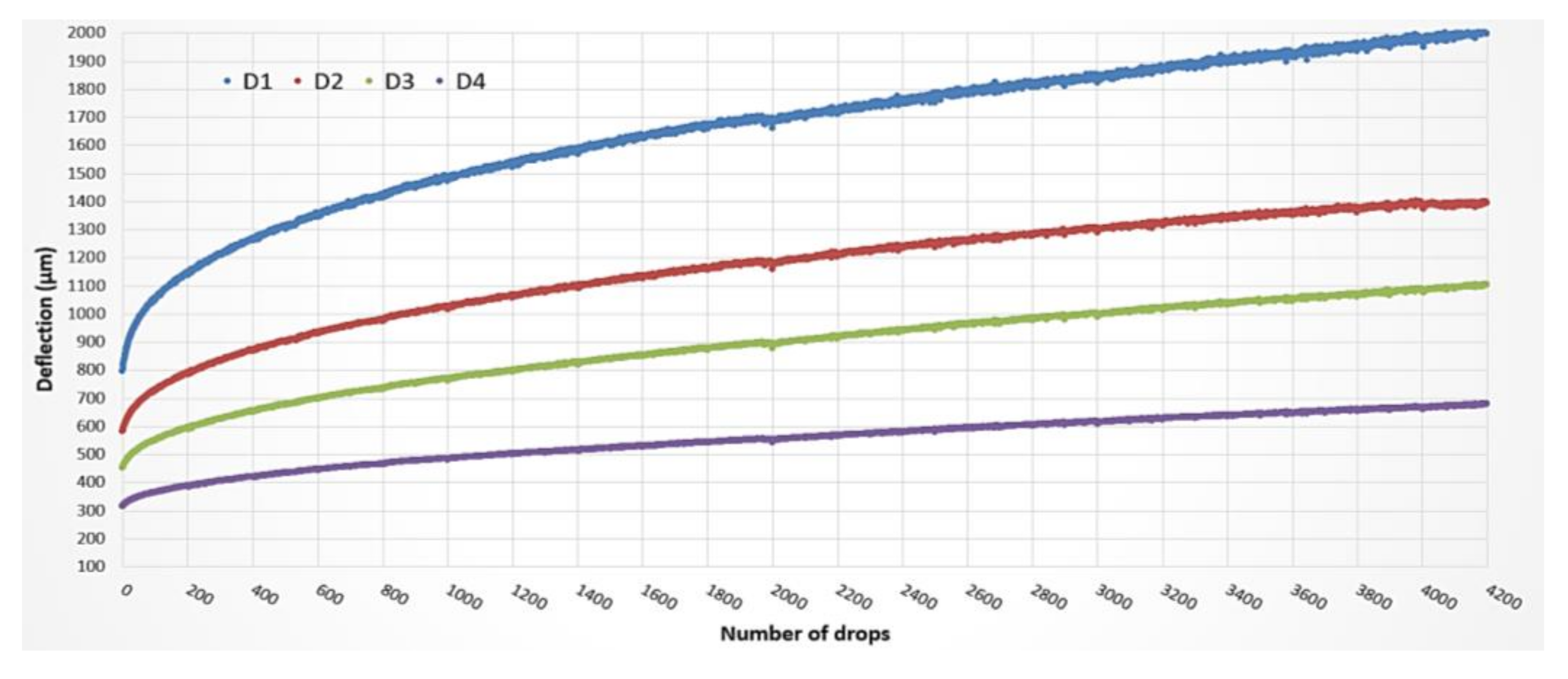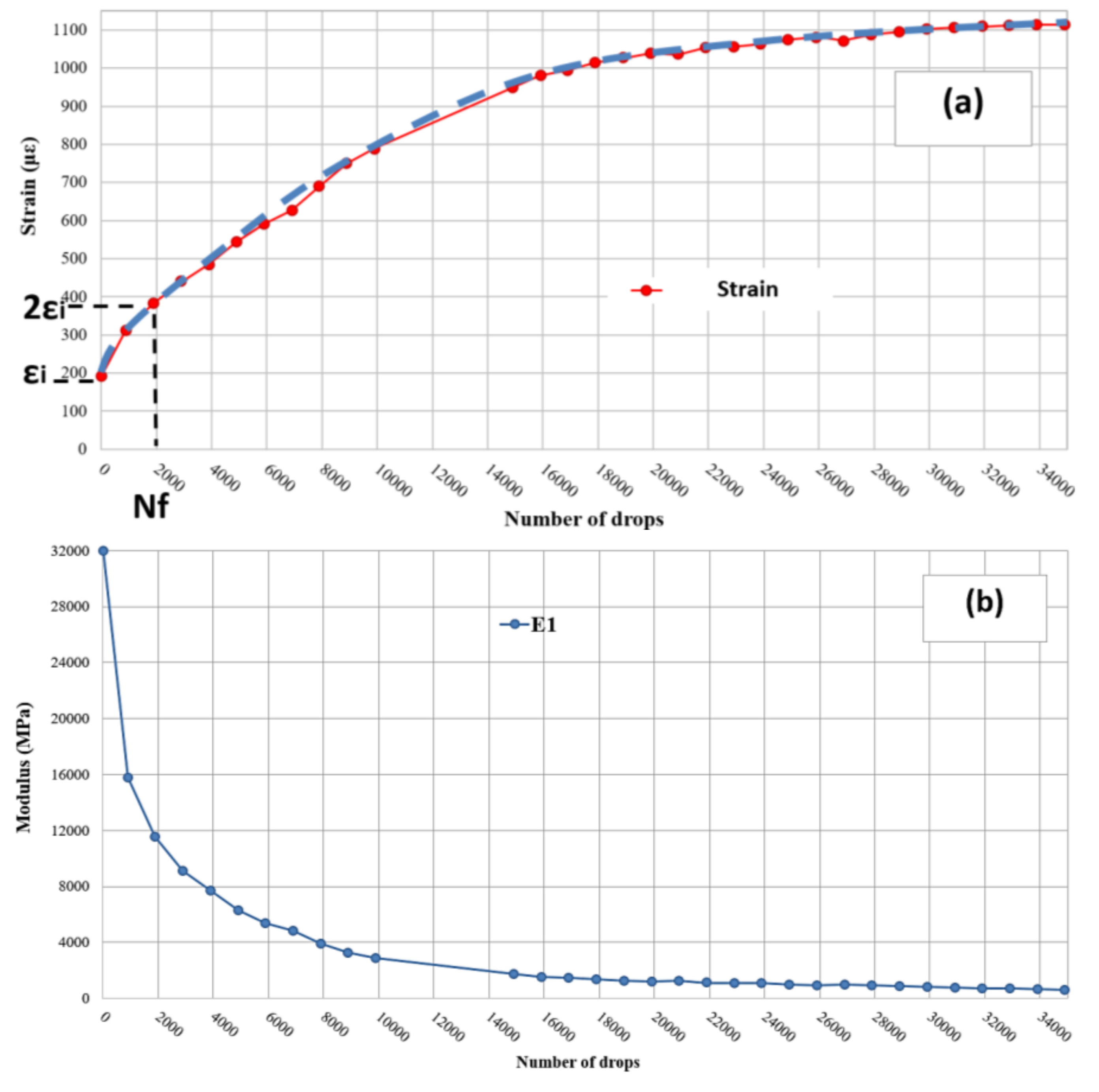1. Introduction
Road pavements are built up in several layers constructed from a wide variety of materials and mixtures. They are traditionally classified into three main categories, according to the building materials used as top layers and to their consequent capacity to spread the traffic-induced stresses on road foundation: Flexible pavements (asphalt), rigid pavements (concrete), and semi-rigid pavements (asphalt and cement bound aggregates).
However, an additional alternative, called semi-flexible pavement, has gained much popularity over the past decades. Thanks to its characteristics, this type of pavement has been successfully applied, especially in those areas subjected to heavy and slow-moving loads [
1], e.g., between 1988 and 2000, 165,000 square meters of semi-flexible pavements were constructed at Copenhagen Airport (DK).
The semi-flexible pavement’s top layer is made from Grouted Macadam, a composite pavement material made by an open-graded asphalt skeleton with 20–25% voids into which a highly flowable cementitious slurry is grouted. This hybrid material combines the flexible properties and the lack of joints of asphalt pavements with high static bearing capacity, good rut resistance, and the durability of concrete ones [
2,
3].
On the other hand, Grouted Macadams constitute a poorly understood branch of pavement technology and have generally been relegated to a role in certain specialty and heavy-duty pavements. This is mainly attributable to the complexity of Grouted Macadams’ construction. It is a two-stage operation, slow and expensive, and normally carried out on two consecutive days. First an open-graded asphalt layer designed to achieve a high void content is laid using a traditional asphalt paver. As soon as the asphalt has cooled, a cementitious slurry grout is spread over the surface. The filling of the voids of the asphalt is facilitated by rubber scrapers (squeegees) until the grout reaches the bottom of the layer. Moreover, the beneficial properties of this material are deeply related to the good void connectivity that allows the grout to flow through them and to an adequate workability of the grout to completely fill the voids. Unfilled voids may cause premature pavement failure.
The complexity of the laying process and the significant amount of labor required lead to long realization times and extremely high initial costs, i.e., not less than 4 times a traditional wearing course’s cost. Therefore, the use of semi-flexible pavements has been limited in its field of application and use, e.g., airport aprons, ports, and industrial storage areas, etc. [
4,
5].
During the last few years, an innovative material has been developed. The basic idea was to find a smart alternative to Grouted Macadam, which could be more easily employed in road pavement applications and at a lower cost.
This material, called Ready to Mix (RTM), should provide similar or even superior characteristics compared to traditional Grouted Macadam while reducing construction times and avoiding the need for dividing the laying process.
During the development stages of the mixture, undertaken in the laboratory (the main results of the laboratory optimization phase are reported in
Table 1), the potential benefits of using the RTM as a structural layer have been highlighted, and not just as an improved wearing course (such as the Grouted Macadam). Considering that the Grouted Macadam is not expected to be used as a base layer of a pavement structure, a proper comparison between Grouted Macadam and RTM cannot be undertaken, even if the Grouted Macadam represents the original inspiration of the RTM, i.e., the same type of structure coarse aggregates coated by a bituminous mortar (cold mix in the case of RTM) and bituminous film constitute the “elastic bridge” between the stones and the cement mortar.
Considering that the primary purpose of our present research activity is to evaluate the material’s properties and its resistance to dynamic load repetitions through the induced changes in field moduli and deformation trends [
6].
During a first laboratory testing phase, which involved studying, characterizing, and comparing different mixtures, the optimum Ready to Mix’s composition was identified.
This mixture is characterized by a high stiffness modulus (about 27,000 MPa, compared to the standard 12,000 MPa of Grouted Macadam) and a high resistance to dynamic load repetitions (no failure using the maximum load achievable by the asphalt standard testing machine), chemical agents, fuels, and temperatures (EN 12697-26; EN 13286-41; EN 13286-42; EN 12697-24; EN 7087). More details regarding the laboratory testing and results will be part of other papers.
The mechanical characteristics, i.e., ITS and Resilient Modulus, of RTM are significantly higher than the Grouted Macadams’ ones (
Table 1). The fatigue resistance of RTM is impressively high, while there is no information about the fatigue characteristics of Grouted Macadam, since this type of material is exclusively used as wearing course.
After this first laboratory investigation phase, wherein different mixtures have been tested and ranked, the highest performing one has been produced in a specifically designed plant, laid, and further studied by means of in-situ tests.
The experiences reported in this paper are part of an ongoing research activity to evaluate the in-situ properties and long-term performance of the Ready to Mix mixture. The main aim of this research was a preliminary evaluation of RTM’s in-situ properties and its structural evolution.
To evaluate the field performances of this material, two different trial sections have been designed and laid, and two different Accelerated Pavement Tests (APTs) have been carried out.
The in-situ APT tests have been undertaken using an innovative device, called Fast Falling Weight Deflectometer (FFWD). This device, which is able to apply a high number of impulsive loads in a short period of time on the pavement surface and record the deflections at different distances from the load application, is a feasible device with which to perform a quick in-field evaluation of new material.
2. Materials and Methods
2.1. Ready to Mix
Ready to Mix (RTM) is an innovative material for semi-flexible pavement wearing course. It was initially developed as a smart alternative to the traditional Grouted Macadam, which is little-used due its complexity and high cost of realization.
RTM is made by aggregates wrapped in a bituminous emulsion film and mixed with a special designed cementitious reactive filler and water, conveniently dosed to give to the mixture superior characteristics when compared to Grouted Macadam (the laboratory RTM’s composition is reported in
Table 2).
The grain size distribution of the initial aggregate mixture, after the introduction of the active filler, is reported in
Figure 1 and is based on the specifications provided by the Italian Road Authorities [
7,
8] for asphalt binder course. The same specifications were adopted also for other characteristics requested for coarse and fine aggregates. The coarse aggregates are cold mixed with a slow-setting cationic bituminous emulsion (ECL 60-type C60B4, according to EN 13808) specifically designed for this purpose.
The cementitious grout is obtained by carefully calibrating the optimum fluid content (derived from the water added through bitumen emulsion) in combination with a specially designed reactive filler (R2M Flowflex, CVR, Gubbio, Italy), which was developed to provide the mixture with its desired characteristics: high stiffness, and thanks to the presence of the elastomeric polymers, an extremely high resistance to dynamic load repetitions (fatigue). The “R2M Flowflex” reactive filler is premixed with cement binder, polymers, and micro-silica sand. Its composition is reserved and patented.
The percentage of reactive filler must be in the range of 30 ± 5% in weight of the total mixture, while the percentage of the bitumen emulsion is requested in the range of 4.6% ÷ 6.8%. The final percentages of the components come out from the mix design.
For both test trial sections investigated, the material has been laid via a traditional asphalt paver and dosed accurately with the correct content of water in the mixture in order to produce the right consistency.
2.2. Fast Falling Weight Deflectometer-FastFWD
Traditionally in-situ pavement response and performance can be evaluated and studied by means of Accelerated Pavement Testing (APT), which has been defined by Metcalf, as “the controlled application of a prototype wheel loading (…) to determine pavement response and performance under a controlled, accelerated accumulation of damage in a compressed time period” [
9].
Accelerated Pavement Tests are able to determine pavement response and performance under a controlled, accelerated accumulation of damage, simulating field conditions. The goal of APT instrumentation is to subject an examined pavement to an extremely high number of cycles in a compressed period of time. These cycles allow for the study of the pavement’s performance evolution by monitoring the changes in deflections, moduli, and the damage growth until a failure condition is reached. These observations can be used to forecast the fatigue life of pavement structures.
In the last forty years, many full-scale APT tests have been performed to evaluate the health conditions of pavements and their performance over time in order to consequently organize and plan maintenance activities.
Unfortunately, the accessibility to expensive full-scale APT devices is limited and facilities, budgets, staff, and time limitations can preclude the use of fixed tracks and full scale APTs. For this reason, great effort has been devoted to the development of a compact and economical structural testing device to quickly study and evaluate new material properties.
To fulfill the need of a smaller, compact, cheaper, and accessible testing device in recent years, a new generation of Falling Weight Deflectometer, called Fast Falling Weight Deflectometer (FastFWD) (Dynatest, Copenaghen, Denmark), has been developed (the main characteristics of FFWD and APT test setup are reported in
Table 3).
As the FWD, it is used to measure the deflections induced by an impulsive load at different radial distances from the load application. Furthermore, the deflectometric data output can be analyzed and backcalculated through ELMOD 6 software (Dynatest, Copenaghen, Denmark). This software can be utilized to compute the effective stiffness of the pavement’s layers and to assess the remaining useful life of the infrastructure.
The load lifting system distinguishes this device from the previously produced one (FWD). It allows one to carry out measurements at a much faster rate than the traditional FWD, i.e., up to 5 times faster per drop. The improved speed of the device and its ability to apply full scale truck wheel loads to the pavement surface suggests that the FastFWD might be a viable faster alternative to full-scale APT for pavement evaluation, to characterize pavement deformations and damage potential and to quickly evaluate new materials.
Some recent studies have shown that the FastFWD could be used as an intermediate tool between small-scale laboratory tests (bending beam, shear, and triaxial tests) and full-scale accelerated pavement tests to characterize material for road use and consequently estimate the useful life of a road pavement [
10,
11,
12,
13].
4. Discussion
The innovative material called Ready to Mix (RTM) was initially developed to be used as a semi-flexible pavement wearing course with comparable or even better characteristics and lower construction costs when compared to traditional Grouted Macadam (the Grouted Macadam costs about 9 €/sqm·cm, while RTM costs about 6.5 €/sqm·cm). During the first laboratory characterization of the material, it has shown excellent performance in terms of stiffness and dynamic load repetitions. For this reason, the material properties and performance have been investigated to evaluate the possibility of its application as a structural layer.
As an additional research activity on RTM, the resistance to repeated loads and its characteristics were investigated by means of field tests. Two different APT trial tests were carried out using the FastFWD, and the moduli evolution and surface deflections trends have been studied and evaluated.
These tests, specifically designed and planned, have highlighted the properties and the high resistance of RTM to dynamic repeated loads, despite its high stiffness.
During the first test session, the failure condition was never reached. Nevertheless, some observations have been made regarding the ability of the material to partly restore its stiffness after a rest period, i.e., its self-healing properties, and its temperature insensitivity.
Thanks to the second field test, it is possible to identify a specific performance relationship that correlates the number of loads to failure with the initial deformation induced in the material by the test load. Since no evidence of cracks or permanent deformation was produced on the tested surface at the end of the surveys, the relationship can be considered conservative.
The results of experimental field tests confirm the promising properties of the RTM when subjected to a great number of load repetitions.
According to the preliminary technical evaluations and the cost analysis undertaken on the trial fields experience basis, this material seems to combine the best properties of the asphalt pavements (self-healing properties, durability, and the possibility to use the asphalt concrete pavers) and temperature resistance stiffness, and high resistance to point loads typical of cement concrete pavements. At the same time, it is easier and less expensive to be laid (about 25% less) by not requiring the laying process to be divided into two subsequent stages. Realization times and initial costs are consequently reduced.
Moreover, the test identified a practical performance relationship for pavement evaluation using the FFWD as an APT device.
The investigation method presented in the paper can provide useful information regarding the long-term mechanical properties of standard or innovative materials like the one tested within the present research activity.
To reach a complete validation of the material under different loading and temperature conditions, additional research activities and a mechanistic comparison with traditional Grouted Macadam are still ongoing.
